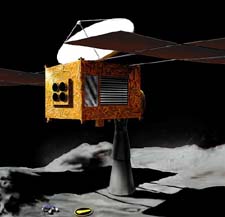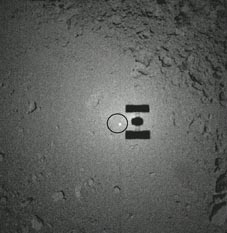
The Japanese spacecraft Hayabusa ('Falcon') prepares to obtain a sample of the asteroid 25143 Itokawa. Two pellets fired down through the cone kicked up surface matter for collection.
Courtesy Japan Aerospace Exploration Agency.
Early this morning, Japanese scientists and engineers gathered in their Deep Space Control Room, awaiting confirmation that the Hayabusa spacecraft had landed on a distant asteroid and grabbed a sample of its dusty surface. Someone hung an embroidered amulet on one of the computer consoles for good luck, and that gesture seemingly helped the trouble-prone craft to succeed.
At about 7:30 a.m. Japan time, Hayabusa (Japanese for "falcon") briefly touched down on 25143 Itokawa in a flat, relatively featureless area informally dubbed Muses Sea. Then it quickly fired two metal pellets into the surface, timed just 0.2 second apart, and collected some of the dust kicked up by the impacts. Throughout the descent and sampling, the spacecraft functioned autonomously, navigating to the surface without intervention from controllers on Earth.
Today's sampling operation went smoothly, say officials of the Japan Aerospace Exploration Agency, though after leaving the surface a thruster problem arose that forced ground controllers to place the craft in a "safe" (standby) mode. "Actually we were seeing the sign of this problem during the descent phase," notes project manager Junichiro Kawaguchi. "But at that time we switched to the backup system and continued the descent."
According to Kawaguchi, the problem caused some loss of propellant, which was already in short supply, and probably involves one or two malfunctioning thrusters. Operations continue normally for now, he said, though the propellant loss has "definitely raised the bar" for getting Hayabusa back to Earth.
Today's success will be the final landing on Itokawa for a technologically challenging mission that has had more than its share of misfortune. Hayabusa lost two attitude-stabilizing "control wheels" before reaching its target on September 12th, leaving just one wheel, plus thruster rockets, to maneuver the spacecraft around Itokawa and maintain its orientation. On November 12th, during a dress rehearsal for the first of two sampling runs, Hayabusa released a small instrumented probe named Minerva that was supposed to land on Itokawa. But instead, because of unfortunate timing, it drifted off into space and was lost.

The Japanese spacecraft Hayabusa casts its shadow on the asteroid 25143 Itokawa while hovering just 32 meters (105 feet) above the surface on November 20, 2005. Telemetry indicates that the craft did land on Itokawa and remain there for more than 30 minutes — but it did not collect a sample as planned. To aid its descent Hayabusa released a small reflective target marker (circled).
Courtesy Japan Aerospace and Exploration Agency.
The mission's most puzzling events occurred on November 20th, during the first sampling attempt. According to an analysis by JASA engineers, Hayabusa descended as planned to Itokawa's surface, bouncing twice before coming to a stop. It remained there for 30 minutes — yet did not fire a 5-gram tantalum pellet into the asteroid as planned. Apparently a landing sensor detected an obstacle in the minutes leading up to touchdown and disabled the firing mechanism as a precaution.
The mission's timetable calls for Hayabusa to begin its return trip to Earth about December 10th, and if all goes well its sample-bearing reentry capsule will land in the Australian Outback near Woomera in June 2007.
Named for the late Hideo Itokawa, considered the father of Japanese rocketry, the irregularly shaped asteroid measures about 550 by 180 meters and appears to have a stony composition similar to that of ordinary chondrites, the most common meteorite type on Earth.
 0
0
Comments
You must be logged in to post a comment.